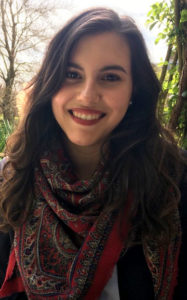The Diagnostic and Statistical Manual of Mental Disorders (DSM-5) has identified communication and interaction with others as specific areas of deficit for many individuals with ASD. Difficulty making eye contact, initiating and sustaining a conversation, code switching, and perspective taking are just some of the areas in which individuals with ASD may exhibit skill deficits. A college student described his social communication challenges once as, “I never know what to say to who, and what reaction I am going to get.”

Samantha Curiale-Feinman, MSEd, TSHH

Alissa Cappelleri, MAT
It is important for individuals with ASD to have opportunities to learn and practice social skills. Traditional, research-based instruction in the areas of social communication and language have included a couple key ingredients (Paul, 2008): 1) Interventions that teach skills in a highly structured fashion; and 2) Opportunities for the learner to participate in direct instruction, modeling, guided practice, and corrective feedback. The COVID-19 pandemic, however, has become an obstacle for individuals who need access to the traditional approach of social skills instruction. In-person classroom opportunities to learn through direction instruction and corrective feedback, modeling of social interaction skills as demonstrated by peers, and social engagement with classroom teachers and peers have all been put on hold for the time being. Which leads us to the question: How do we find opportunities to develop and maintain social skills in a time when traditional social interaction has been limited?
The Traditional Approach to Social Skills Adapted
In this current climate of mandated virtual interactions, there is a clear need to shift how social skills instruction is being delivered. When it comes to developing an action plan, it is first imperative that the motivation for skill development be identified. While there is a standard baseline of skills that an individual benefits from learning, one’s personal motivators must be considered. Asking the following questions in the context of a social distancing and virtual interactions world, may help to identify one’s driving forces behind building communication skills:
- What do you want to participate in?
- What communities do you want to be part of?
- What do you have to participate in?
- What do you need to be a part of?
Once outcomes have been identified, a Behavior Skills Training model can be employed to break down target skills (Johnson et. al, 2005). Through direct instruction, a description of the skill is presented along with its importance or rationale. The purpose is addressed as well as context. Here now lies an opportunity to provide insight to how one will use the skill in both the virtual world and in person. For example, the skill of joining a group and entering conversation appropriately differs depending on context. When in person, a greeting of some sort is expected to establish participation. However, when commenting online, a greeting is seen as superfluous as each new contribution is linked to content being discussed and not necessarily the acknowledgement of participants.
Modeling and practice are essential to social communication instruction as they allow the learner to rehearse novel skills. The virtual world allows for the opportunity to widen practical applications of skills to a much broader network of people available through online platforms. This expanded audience may not have otherwise been considered as practice partners due to geographical restrictions. However, practice may take on a new form with respect to the delivery of feedback. For those working with individuals to foster social skills remotely, the opportunity to observe and offer direct feedback may be shifted solely to on screen practice and reflective thinking, rather than participating in joint in person activities and outings.
How Do We Practice “Real World” Application Without Participating in the “Real World”?
To promote the generalization of social skills, it is imperative to provide opportunities for practice in the natural environment. However, as we settle into the “new normal” of socially interacting from a physical distance, modifications may need to be considered. What has been traditionally considered an “authentic learning environment” for social skills practice has been categorized by physical space. Historically, one would find ways to physically meet in a location they wished to navigate for practice. Since these spaces are now limited or not accessible, it is essential to shift focus to what is available. The present online space lends exceedingly well to this as there are multiple means of engagement for one to practice skills.
From social media to online gaming, virtual communities are being cultivated. Platforms that gather people around a collective interest encourage participation and serve as a great equalizer. Forums that draw attention to a set subject or a game unite towards a common goal and create an inclusive environment for social skills practice. Once engaged in conversation surrounding shared interests, one may experience the positive reinforcement of successful participation, and further harness that newfound confidence in other communication opportunities.
How Can We Find ORGANIC Opportunities?
It is also essential to create viable and authentic opportunities to engage with peers in a supported environment. An organic opportunity is one where participants are engaging freely. Looking to the “Autcraft community” that has found a home on the online gaming platform of Minecraft, Dr. Kathryn Ringland has been able to observe essential tenets to structured social opportunities that enable room for a naturalistic environment (Rignland 2019).
Having a shared thread for learning, supportive peers, and dedicated community “space” are all essential for structuring practice. Options for leadership and growth exist as those develop confidence and serve as models to others. For group instruction, all participants are presented with the same visual and auditory access. Methods of direct feedback need to be fleshed out in a way that redirects behavior without pointing fingers.
Preparing individuals to participate in open platforms is essential as unwritten social rules reign supreme. All members of an online community are open and available for scrutiny. There are no edges of the party to seek solace as there are no walls in these communities. The idea of ascribing physical aspects to virtual space is one that the “Autcraft community” has found helpful. In immersing themselves in the culture of gaming has allowed for players to take the confidence fostered there and transfer skills to other platforms. Using this example as a case study, it is clear that other social groups can be established through the idea of community. In this time of isolated living, people are seeking ways to engage beyond. The shared experience creates a universality and evens out the playing field. A culture of care is established that naturally grants opportunities to branch out in developing social skills while still being physically comfortable with what one knows.
Alissa Cappelleri, MAT, Coordinator, and Samantha Feinman, MSEd, TSHH, Director, New Frontiers Executive Function Coaching, can be reached at info@nfil.net or 646-558-0085.
References
American Psychiatric Association. (2013). Diagnostic and statistical manual of mental disorders (5th ed.). Arlington, VA: Author.
Johnson, B.M., Miltenberger, R.G., Egemo-Helm, K., Jostad, C. J., Flessner, C., & Gatheridge, B. (2005). Evaluation of behavioural skills training for teaching abduction-prevention skills to young children. Journal of Applied Behavior Analysis, 38, 67-78.
Paul, R. (2008). Interventions to improve communication. Child and Adolescent Psychiatric Clinics of North America, 17(4), 835-856.
Ringland, K. E. (2019, March). “Autsome”: Fostering an Autistic Identity in an Online Minecraft Community for Youth with Autism. In International Conference on Information (pp. 132-143). Springer, Cham.
Ringland, K. E. (2017). Who Has Access? Making Accessible Play Spaces in Minecraft for Children with Autism. Analog Games Studies, 4(3).





[…] Original Article […]